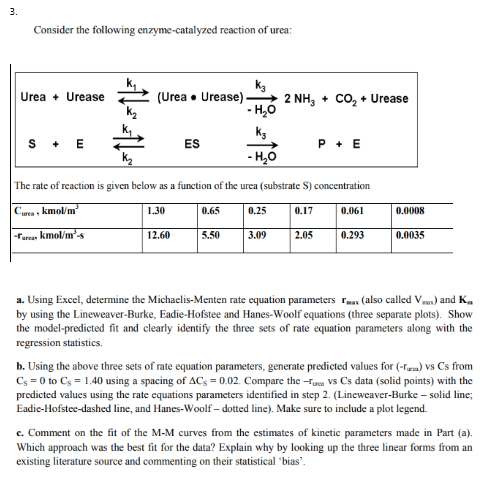3. Consider the following enzyme-catalyzed reaction of urea Urea + Urease (Urea. Urease)-> 2 NH, + CO2-urease ES The rate of reaction is given below as a function of the urea (substrate S) concentration Curea, kmol/m .30 0.65 0.25 0.17 0.061 0.0008 urea kmol/m-s 12.60 5.50 3.09 2.05 0.293 0,0035 a. Using Excel, determine the Michaelis-Menten rate equation parameters ra (also called V and K. by using the Lineweaver-Burke, Eadie-Hofstee and Hanes-Woolf equations (three separate plots). Show the model-predicted fit and clearly identify the three sets of rate equation parameters along with the regression statistics b. Using the above three sets of rate equation parameters, generate predicted values for ) vs Cs from Cs-0 to Cs-1.40 using a spacing of ACs-0.02. Compare the -S Cs data (solid points) with the predicted values using the rate equations parameters identified in step 2. (Lineweaver-Burke - solid line; Eadie-Hofstee-dashed line, and Hanes-Woolf- dotted line). Make sure to include a plot legend. e. Comment on the fit of the M-M curves from the estimates of kinetic parameters made in Part (a). Which approach was the best fit for the data? Explain why by looking up the three linear forms from an existing literature source and commenting on their statistical 'bias
3. Consider the following enzyme-catalyzed reaction of urea Urea + Urease (Urea. Urease)-> 2 NH, + CO2-urease ES The rate of reaction is given below as a function of the urea (substrate S) concentration Curea, kmol/m .30 0.65 0.25 0.17 0.061 0.0008 urea kmol/m-s 12.60 5.50 3.09 2.05 0.293 0,0035 a. Using Excel, determine the Michaelis-Menten rate equation parameters ra (also called V and K. by using the Lineweaver-Burke, Eadie-Hofstee and Hanes-Woolf equations (three separate plots). Show the model-predicted fit and clearly identify the three sets of rate equation parameters along with the regression statistics b. Using the above three sets of rate equation parameters, generate predicted values for ) vs Cs from Cs-0 to Cs-1.40 using a spacing of ACs-0.02. Compare the -S Cs data (solid points) with the predicted values using the rate equations parameters identified in step 2. (Lineweaver-Burke - solid line; Eadie-Hofstee-dashed line, and Hanes-Woolf- dotted line). Make sure to include a plot legend. e. Comment on the fit of the M-M curves from the estimates of kinetic parameters made in Part (a). Which approach was the best fit for the data? Explain why by looking up the three linear forms from an existing literature source and commenting on their statistical 'bias
Introduction to Chemical Engineering Thermodynamics
8th Edition
ISBN:9781259696527
Author:J.M. Smith Termodinamica en ingenieria quimica, Hendrick C Van Ness, Michael Abbott, Mark Swihart
Publisher:J.M. Smith Termodinamica en ingenieria quimica, Hendrick C Van Ness, Michael Abbott, Mark Swihart
Chapter1: Introduction
Section: Chapter Questions
Problem 1.1P
Related questions
Question

Transcribed Image Text:3.
Consider the following enzyme-catalyzed reaction of urea
Urea + Urease
(Urea. Urease)-> 2 NH, + CO2-urease
ES
The rate of reaction is given below as a function of the urea (substrate S) concentration
Curea, kmol/m
.30
0.65
0.25
0.17
0.061
0.0008
urea kmol/m-s
12.60
5.50
3.09
2.05
0.293
0,0035
a. Using Excel, determine the Michaelis-Menten rate equation parameters ra (also called V and K.
by using the Lineweaver-Burke, Eadie-Hofstee and Hanes-Woolf equations (three separate plots). Show
the model-predicted fit and clearly identify the three sets of rate equation parameters along with the
regression statistics
b. Using the above three sets of rate equation parameters, generate predicted values for ) vs Cs from
Cs-0 to Cs-1.40 using a spacing of ACs-0.02. Compare the -S Cs data (solid points) with the
predicted values using the rate equations parameters identified in step 2. (Lineweaver-Burke - solid line;
Eadie-Hofstee-dashed line, and Hanes-Woolf- dotted line). Make sure to include a plot legend.
e. Comment on the fit of the M-M curves from the estimates of kinetic parameters made in Part (a).
Which approach was the best fit for the data? Explain why by looking up the three linear forms from an
existing literature source and commenting on their statistical 'bias
Expert Solution
This question has been solved!
Explore an expertly crafted, step-by-step solution for a thorough understanding of key concepts.
This is a popular solution!
Trending now
This is a popular solution!
Step by step
Solved in 8 steps with 8 images

Recommended textbooks for you

Introduction to Chemical Engineering Thermodynami…
Chemical Engineering
ISBN:
9781259696527
Author:
J.M. Smith Termodinamica en ingenieria quimica, Hendrick C Van Ness, Michael Abbott, Mark Swihart
Publisher:
McGraw-Hill Education

Elementary Principles of Chemical Processes, Bind…
Chemical Engineering
ISBN:
9781118431221
Author:
Richard M. Felder, Ronald W. Rousseau, Lisa G. Bullard
Publisher:
WILEY

Elements of Chemical Reaction Engineering (5th Ed…
Chemical Engineering
ISBN:
9780133887518
Author:
H. Scott Fogler
Publisher:
Prentice Hall

Introduction to Chemical Engineering Thermodynami…
Chemical Engineering
ISBN:
9781259696527
Author:
J.M. Smith Termodinamica en ingenieria quimica, Hendrick C Van Ness, Michael Abbott, Mark Swihart
Publisher:
McGraw-Hill Education

Elementary Principles of Chemical Processes, Bind…
Chemical Engineering
ISBN:
9781118431221
Author:
Richard M. Felder, Ronald W. Rousseau, Lisa G. Bullard
Publisher:
WILEY

Elements of Chemical Reaction Engineering (5th Ed…
Chemical Engineering
ISBN:
9780133887518
Author:
H. Scott Fogler
Publisher:
Prentice Hall


Industrial Plastics: Theory and Applications
Chemical Engineering
ISBN:
9781285061238
Author:
Lokensgard, Erik
Publisher:
Delmar Cengage Learning

Unit Operations of Chemical Engineering
Chemical Engineering
ISBN:
9780072848236
Author:
Warren McCabe, Julian C. Smith, Peter Harriott
Publisher:
McGraw-Hill Companies, The